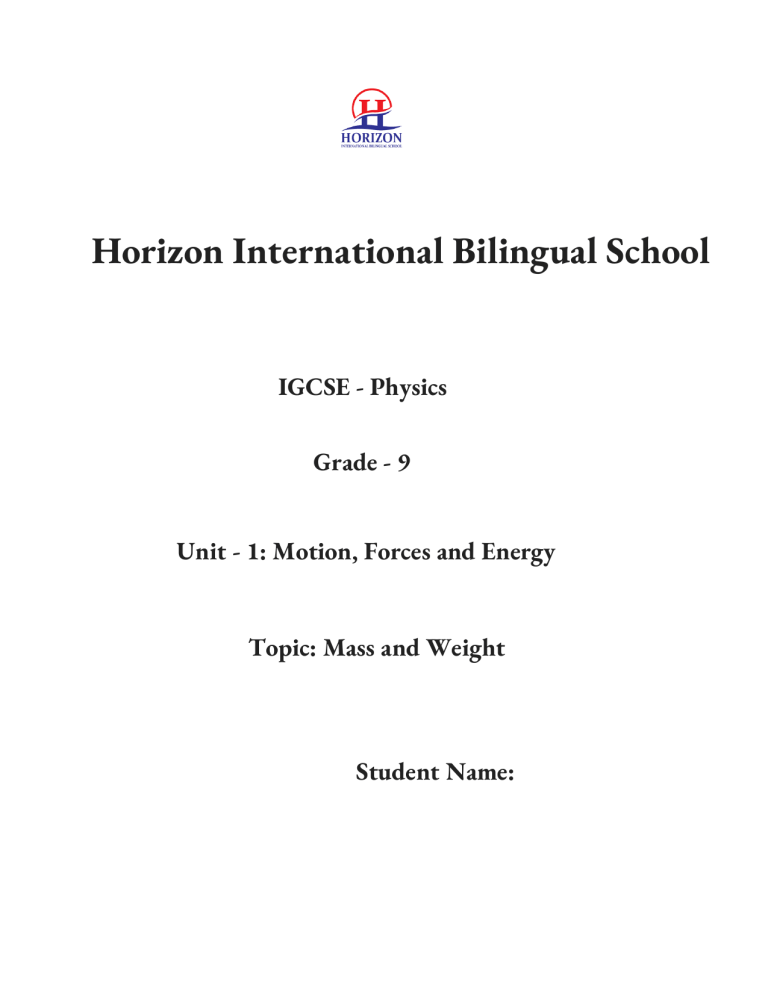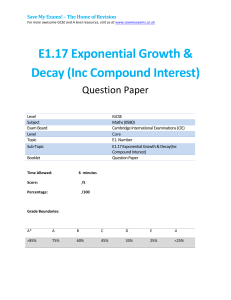
Horizon International Bilingual School IGCSE - Physics Grade - 9 Unit - 1: Motion, Forces and Energy Topic: Mass and Weight Student Name: Save My Exams! – The Home of Revision For more awesome GCSE and A level resources, visit us at www.savemyexams.co.uk/ 1 Fig. 3.1 shows an early water-powered device used to raise a heavy load. The heavy load rests on piston B. cylinder A cylinder B load water piston A piston B connecting rod connecting rod pivot beam Fig. 3.1 (not to scale) Initially, a large weight of water in cylinder A pushes piston A down. This causes the left-hand end of the beam to move down and the right-hand end of the beam to move up. Piston B rises, lifting the heavy load. (a) The weight of water in cylinder A is 80 kN. Calculate the mass of water in cylinder A. mass = ................................................ [2] Save My Exams! – The Home of Revision For more awesome GCSE and A level resources, visit us at www.savemyexams.co.uk/ (b) The density of water is 1000 kg / m3. Calculate the volume of water in cylinder A. volume = ................................................ [2] (c) Piston A moves down a distance of 4.0 m. Calculate the gravitational potential energy lost by the water. loss of gravitational potential energy = ................................................ [2] (d) The heavy load lifted by piston B gains 96 kJ of gravitational potential energy. Calculate the efficiency of the device. efficiency = ................................................ [2] [Total: 8] Save My Exams! – The Home of Revision For more awesome GCSE and A level resources, visit us at www.savemyexams.co.uk/ 2 (a) A water tank has a rectangular base of dimensions 1.5 m by 1.2 m and contains 1440 kg of water. Calculate (i) the weight of the water, weight = ............................................... [1] (ii) the pressure exerted by the water on the base of the tank. pressure = ............................................... [2] (b) Fig. 5.1 shows two water tanks P and Q of different shape. Both tanks are circular when viewed from above. The tanks each contain the same volume of water. The depth of water in both tanks is 1.4 m. 1.4 m P Q Fig. 5.1 (i) The density of water is 1000 kg / m3. The pressures exerted by the water on the base of the two tanks are equal. Calculate this pressure. pressure = ............................................... [2] Save My Exams! – The Home of Revision For more awesome GCSE and A level resources, visit us at www.savemyexams.co.uk/ (ii) Equal small volumes of water are removed from each tank. State which tank, P or Q, now has the greater water pressure on its base. Explain your answer. ........................................................................................................................................... ........................................................................................................................................... ...................................................................................................................................... [2] [Total: 7] Save My Exams! – The Home of Revision For more awesome GCSE and A level resources, visit us at www.savemyexams.co.uk/ 3 Fig. 2.1 shows a uniform, rectangular slab of concrete ABCD standing upright on the ground. The slab has height 0.60 m, width 0.30 m and mass 18 kg. A force of 40 N acts horizontally to the left at B. A B 40 N 0.60 m D C 0.30 m Fig. 2.1 (a) (i) Calculate the weight W of the concrete slab. W = ........................................................ [1] (ii) The thickness of the slab is 0.040 m. Calculate the pressure exerted by the slab on the ground. pressure = ........................................................ [2] Save My Exams! – The Home of Revision For more awesome GCSE and A level resources, visit us at www.savemyexams.co.uk/ (b) (i) (ii) On Fig. 2.1, draw and label an arrow to show the weight W of the slab acting at its centre of mass. [1] Calculate 1. the moment of the 40 N force about point D, moment = ........................................................ 2. the moment of W about point D. moment = ........................................................ [3] (iii) The ground is rough so that the slab does not slide. State and explain what happens to the slab as the horizontal force at B is gradually increased. ........................................................................................................................................... ........................................................................................................................................... .......................................................................................................................................[2] [Total: 9] Save My Exams! – The Home of Revision For more awesome GCSE and A level resources, visit us at www.savemyexams.co.uk/ 4 A large crane has a mass of 8500 kg. Fig. 4.1 shows the crane on a muddy building-site. lifting-arm hook axle caterpillar tracks Fig. 4.1 (a) Calculate the weight of the crane. weight = .................................................. [1] (b) The crane rests on two caterpillar tracks each of which has a contact area with the ground of 3.4 m2. (i) Calculate the pressure that the crane exerts on the ground. pressure = .................................................. [2] Save My Exams! – The Home of Revision For more awesome GCSE and A level resources, visit us at www.savemyexams.co.uk/ (ii) As the crane driver walks towards the crane, he starts to sink into the mud. He lays a wide plank of wood on the mud and he walks along the plank. Explain why he does not sink into the mud when he walks along the plank. .................................................................................................................................. .................................................................................................................................. ............................................................................................................................. [2] (c) When the crane lifts a heavy load with its hook, the load exerts a moment on the lifting-arm about the axle. (i) Explain what is meant by moment of a force. .................................................................................................................................. ............................................................................................................................. [1] (ii) Despite the moment exerted on the lifting-arm, the crane remains in equilibrium. State the two conditions required for any object to be in equilibrium. 1. .............................................................................................................................. 2. .............................................................................................................................. [2] [Total: 8] Save My Exams! – The Home of Revision For more awesome GCSE and A level resources, visit us at www.savemyexams.co.uk/ 5 Fig. 2.1 shows a mobile bird sculpture that has been created by an artist. tail bird sculpture pivot M hole in sculpture for pivot 12 cm E 30 cm Fig. 2.1 M is the centre of mass of the bird sculpture, including its tail (but not including the counter-weight that will be added later). The mass of the bird and tail is 1.5 kg. The bird sculpture is placed on a pivot. The artist adds the counter-weight at the end E of the tail so that the bird remains stationary in the position shown. (a) Calculate the mass of the counter-weight. mass = ................................................. [2] (b) The centre of mass of the sculpture with counter-weight is at the pivot. Calculate the upward force acting at the pivot. force = ................................................. [1] Save My Exams! – The Home of Revision For more awesome GCSE and A level resources, visit us at www.savemyexams.co.uk/ (c) The sculpture is rotated clockwise to the position shown in Fig. 2.2. It is held still, then carefully released. M pivot counter-weight Fig. 2.2 (i) State whether the sculpture will stay in that position, rotate further clockwise or rotate back anticlockwise. .................................................................................................................................. .................................................................................................................................. (ii) Explain your answer to (i). .................................................................................................................................. .................................................................................................................................. .................................................................................................................................. .................................................................................................................................. [3] [Total: 6]




